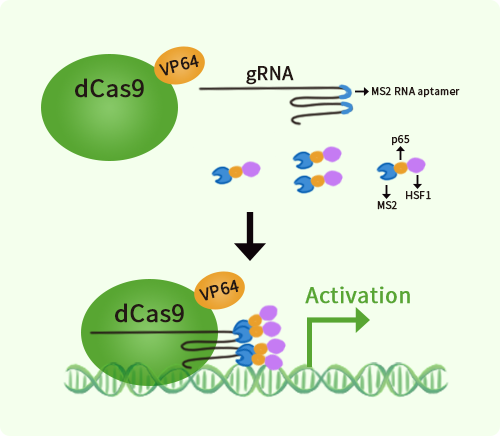Mouse Top3a activation kit by CRISPRa
CAT#: GA204415
Top3a CRISPRa kit - CRISPR gene activation of mouse topoisomerase (DNA) III alpha
Find the corresponding CRISPRi Inhibitor Kit
USD 1,657.00
2 Weeks*
Specifications
| Product Data | |
| Format | 3 gRNAs (5ug each), 1 scramble ctrl (10ug) and 1 enhancer vector (10ug) |
| Symbol | Top3a |
| Locus ID | 21975 |
| Kit Components | GA204415G1, Top3a gRNA vector 1 in pCas-Guide-GFP-CRISPRa GA204415G2, Top3a gRNA vector 2 in pCas-Guide-GFP-CRISPRa GA204415G3, Top3a gRNA vector 3 in pCas-Guide-GFP-CRISPRa 1 CRISPRa-Enhancer vector, SKU GE100056 1 CRISPRa scramble vector, SKU GE100077 |
| Disclaimer | These products are manufactured and supplied by OriGene under license from ERS. The kit is designed based on the best knowledge of CRISPRa SAM technology. The efficiency of the activation can be affected by many factors, including nucleosome occupancy status, chromatin structure and the gene expression level of the target, etc. |
| Reference Data | |
| RefSeq | NM_009410 |
| UniProt ID | O70157 |
| Synonyms | MGC106383 |
| Summary | Releases the supercoiling and torsional tension of DNA introduced during the DNA replication and transcription by transiently cleaving and rejoining one strand of the DNA duplex. Introduces a single-strand break via transesterification at a target site in duplex DNA. The scissile phosphodiester is attacked by the catalytic tyrosine of the enzyme, resulting in the formation of a DNA-(5'-phosphotyrosyl)-enzyme intermediate and the expulsion of a 3'-OH DNA strand. The free DNA strand then undergoes passage around the unbroken strand thus removing DNA supercoils. Finally, in the religation step, the DNA 3'-OH attacks the covalent intermediate to expel the active-site tyrosine and restore the DNA phosphodiester backbone. As an essential component of the RMI complex it is involved in chromosome separation and the processing of homologous recombination intermediates to limit DNA crossover formation in cells. Has DNA decatenation activity. It is required for mtDNA decatenation and segregation after completion of replication, in a process that does not require BLM, RMI1 and RMI2.[UniProtKB/Swiss-Prot Function] |
Documents
| Product Manuals |
| FAQs |
| SDS |
Resources
Other Versions
| SKU | Description | Size | Price |
|---|---|---|---|
| KN518061 | Top3a - KN2.0, Mouse gene knockout kit via CRISPR, non-homology mediated. |
USD 1,657.00 |
{0} Product Review(s)
Be the first one to submit a review






























































































































































































































































 Germany
Germany
 Japan
Japan
 United Kingdom
United Kingdom
 China
China
